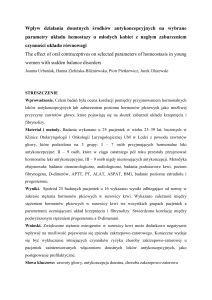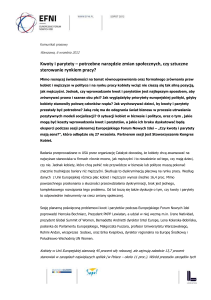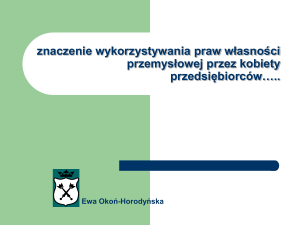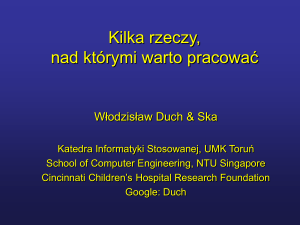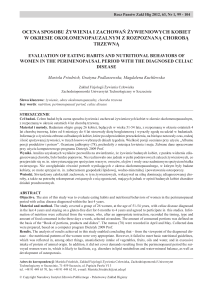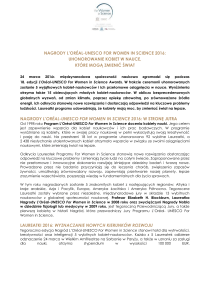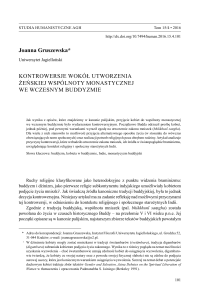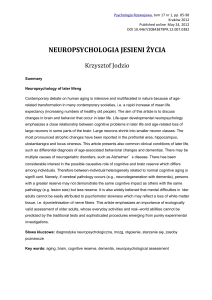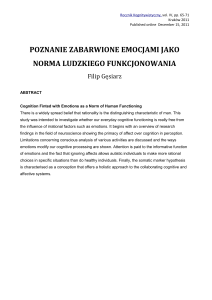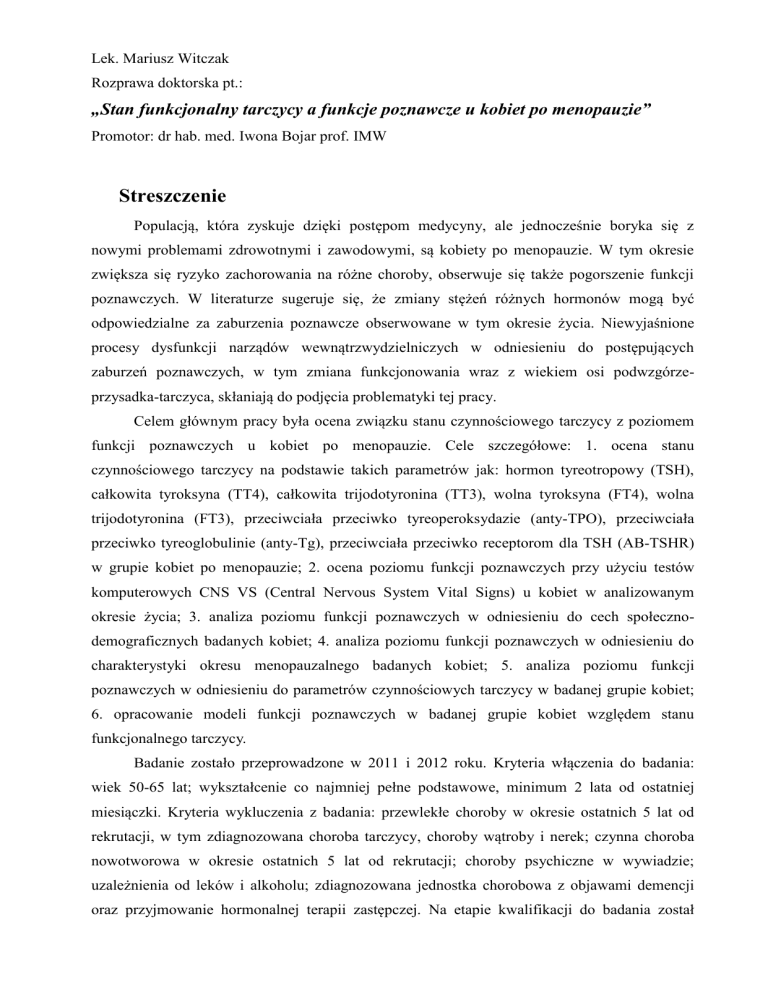
Lek. Mariusz Witczak
Rozprawa doktorska pt.:
„Stan funkcjonalny tarczycy a funkcje poznawcze u kobiet po menopauzie”
Promotor: dr hab. med. Iwona Bojar prof. IMW
Streszczenie
Populacją, która zyskuje dzięki postępom medycyny, ale jednocześnie boryka się z
nowymi problemami zdrowotnymi i zawodowymi, są kobiety po menopauzie. W tym okresie
zwiększa się ryzyko zachorowania na różne choroby, obserwuje się także pogorszenie funkcji
poznawczych. W literaturze sugeruje się, że zmiany stężeń różnych hormonów mogą być
odpowiedzialne za zaburzenia poznawcze obserwowane w tym okresie życia. Niewyjaśnione
procesy dysfunkcji narządów wewnątrzwydzielniczych w odniesieniu do postępujących
zaburzeń poznawczych, w tym zmiana funkcjonowania wraz z wiekiem osi podwzgórzeprzysadka-tarczyca, skłaniają do podjęcia problematyki tej pracy.
Celem głównym pracy była ocena związku stanu czynnościowego tarczycy z poziomem
funkcji poznawczych u kobiet po menopauzie. Cele szczegółowe: 1. ocena stanu
czynnościowego tarczycy na podstawie takich parametrów jak: hormon tyreotropowy (TSH),
całkowita tyroksyna (TT4), całkowita trijodotyronina (TT3), wolna tyroksyna (FT4), wolna
trijodotyronina (FT3), przeciwciała przeciwko tyreoperoksydazie (anty-TPO), przeciwciała
przeciwko tyreoglobulinie (anty-Tg), przeciwciała przeciwko receptorom dla TSH (AB-TSHR)
w grupie kobiet po menopauzie; 2. ocena poziomu funkcji poznawczych przy użyciu testów
komputerowych CNS VS (Central Nervous System Vital Signs) u kobiet w analizowanym
okresie życia; 3. analiza poziomu funkcji poznawczych w odniesieniu do cech społecznodemograficznych badanych kobiet; 4. analiza poziomu funkcji poznawczych w odniesieniu do
charakterystyki okresu menopauzalnego badanych kobiet; 5. analiza poziomu funkcji
poznawczych w odniesieniu do parametrów czynnościowych tarczycy w badanej grupie kobiet;
6. opracowanie modeli funkcji poznawczych w badanej grupie kobiet względem stanu
funkcjonalnego tarczycy.
Badanie zostało przeprowadzone w 2011 i 2012 roku. Kryteria włączenia do badania:
wiek 50-65 lat; wykształcenie co najmniej pełne podstawowe, minimum 2 lata od ostatniej
miesiączki. Kryteria wykluczenia z badania: przewlekłe choroby w okresie ostatnich 5 lat od
rekrutacji, w tym zdiagnozowana choroba tarczycy, choroby wątroby i nerek; czynna choroba
nowotworowa w okresie ostatnich 5 lat od rekrutacji; choroby psychiczne w wywiadzie;
uzależnienia od leków i alkoholu; zdiagnozowana jednostka chorobowa z objawami demencji
oraz przyjmowanie hormonalnej terapii zastępczej. Na etapie kwalifikacji do badania został
przeprowadzony krótki test MoCA celem włączenia do badania kobiet, które nie wykazują cech
demencji. Do badania zakwalifikowano 383 kobiety.
Badanym została pobrana krew do oznaczeń takich parametrów jak: TSH, TT4, TT3, FT4,
FT3, anty-TPO, anty-Tg, AB-TSHR. Ocena funkcji poznawczych została przeprowadzona w
oparciu o aparaturę diagnostyczną funkcji poznawczych CNS-VS (wersja polska). Narzędziem
badawczym, była ponadto ankieta, która składała się z dwóch części: I. cechy społecznodemograficzne badanych; II. wywiad ginekologiczny, oraz nasilenie objawów menopauzalnych,
ocenianych wskaźnikiem Kuppermana i Greene’a.
Statystyczną
analizę
zebranych
danych
wykonano
komputerowym STATISTICA. Przyjęto poziom istotności
w
statystycznym
pakiecie
= 0,05.
Średnia wieku badanych kobiet wynosiła 56,4±3,4 lat. Badane miały stężenia TSH
średnio 1,91±1,35 mU/l. 92% badanych miało stężenie TSH w normie. Stężenie FT3 wynosiło
średnio 4,03±0,63 pmol/l, FT4 14,76±2,34 pmol/l, TT3 1,85±0,31 nmol/l i TT4 99,12±16,98
nmol/l. Stężenie FT4 było u 11% poniżej normy i u dwóch kobiet – powyżej normy. Średnie
stężenia przeciwciał wynosiły 64,74 IU/l dla anty-TPO, 100,69 IU/l dla anty-Tg i 1,40 IU/l dla
AB-TSHR i w przypadku anty-TPO plasowały się powyżej normy. Przedziały norm dla
poszczególnych parametrów tarczycowych podzielono na trzy równe podprzedziały: niskich,
środkowych i wysokich stężeń normy.
Badane kobiety uzyskały indeks neurokognitywny (NCI) średnio na poziomie 84,4 pkt.
Najniższe wyniki uzyskały w testach oceniających plastyczność poznawczą (średnio 78,64 pkt.),
szybkość przetwarzania (średnio 79,25 pkt.) i funkcje wykonawcze (średnio 79,75 pkt.). Wyniki
w
testach
oceniających
skupianie
uwagi
wynosiły
średnio
82,24
pkt.,
szybkość
psychomotoryczną - średnio 83,42 pkt. oraz czas reakcji - średnio 86,87 pkt. Najlepiej wypadły
badane kobiety w testach oceniających pamięć (średnio 90,15 pkt.), w tym werbalną (średnio
91,22 pkt.) i wzrokową (średnio 93,37 pkt.).
Nie stwierdzono zależności między wynikami funkcji poznawczych a wiekiem. Im
wyższy poziom wykształcenia miały badane tym lepsze wyniki osiągały w testach oceniających
NCI oraz cztery funkcje poznawcze: pamięć, pamięć werbalną, szybkość psychomotoryczną i
czas reakcji. Badane kobiety, które mieszkały na wsiach uzyskały istotnie gorsze wyniki w
testach oceniających szybkość psychomotoryczną i czas reakcji niż kobiety mieszkające w
miastach. W NCI oraz wszystkich funkcjach poznawczych z wyjątkiem pamięci wzrokowej
najlepsze wyniki uzyskały kobiety pracujące umysłowo, a gorsze kobiety pracujące fizycznie lub
umysłowo-fizycznie. Nasilenie objawów menopauzalnych u badanych kobiet oceniane za
pomocą skali Greene’a było istotnie ujemnie skorelowane z NCI i większością funkcji
poznawczych.
U kobiet po menopauzie stężenie TSH było ujemnie skorelowane z wynikami NCI,
funkcji wykonawczych, skupiania uwagi i plastyczności poznawczej. Stwierdzono również
różnice NCI, funkcji wykonawczych, szybkości psychomotorycznej, czasu reakcji, skupiania
uwagi i plastyczności poznawczej w zależności od normatywnego (w trzech podprzedziałach
normy) i pozanormatywnego stężenia TSH.
Stężenie FT3 nie było skorelowane liniowo ani z NCI, ani z pozostałymi funkcjami
poznawczymi. Natomiast kobiety, które miały stężenie FT3 w przedziale niskich stężeń normy
uzyskały słabsze wyniki w porównaniu do badanych ze stężeniami FT3 w przedziałach
środkowych lub wysokich stężeń normy. Stężenie FT4 było dodatnio skorelowane z wynikami
szybkości psychomotorycznej. Badane ze stężeniami FT4 poniżej normy osiągały istotnie niższe
wyniki tej funkcji w porównaniu do kobiet ze stężeniami FT4 w przedziałach środkowych i
niskich stężeń normy.
Stwierdzono ujemne korelacje pomiędzy stężeniem TT3 a wynikami pamięci i pamięci
werbalnej. Ze stężeniem TT4 ujemnie korelowały wyniki pamięci i pamięci werbalnej, a oprócz
tego NCI, funkcji wykonawczych i plastyczności poznawczej. Kobiety, których stężenie TT3
mieściło się w przedziale niskich stężeń normy, uzyskiwały lepsze wyniki pamięci i szybkości
psychomotorycznej w porównaniu do kobiet ze stężeniami TT3 w przedziałach środkowych lub
wysokich stężeń normy.
Stwierdzono ujemne korelacje pomiędzy stężeniem anty-TPO a wynikami pamięci,
pamięci werbalnej i szybkości psychomotorycznej. Stężenie anty-Tg korelowało dodatnio z
wynikami czasu reakcji w badanej grupie. Natomiast stężenie AB-TSHR korelowało ujemnie z
wynikami NCI, pamięci, funkcji wykonawczych, szybkości psychomotorycznej, skupiania
uwagi i plastyczności poznawczej. Badane, które miały stężenia
anty-TPO w przedziale
środkowych stężeń normy, uzyskały lepsze wyniki pamięci werbalnej w porównaniu do kobiet
ze stężeniami anty-TPO w przedziale niskich stężeń normy oraz kobiet ze stężeniami anty-TPO
powyżej normy. Lepsze wyniki pamięci wzrokowej miały kobiety ze stężeniami anty-TPO w
przedziale niskich stężeń normy w porównaniu do badanych, u których stężenia anty-TPO
mieściły się w przedziale środkowych stężeń normy i powyżej normy. Istotnie lepsze wyniki
szybkości przetwarzania uzyskały kobiety ze stężeniami anty-TPO w przedziale środkowych
stężeń normy w porównaniu do kobiet, u których stężenia anty-TPO mieściły się w przedziale
niskich stężeń normy i powyżej normy. Wyniki czasu reakcji były istotnie słabsze u badanych ze
stężeniami anty-TPO w przedziale niskich stężeń normy w porównaniu do badanych ze
stężeniami anty-TPO w przedziale środkowych i wysokich stężeń normy. Badane, które miały
stężenia AB-TSHR w przedziale niskich lub środkowych stężeń normy miały istotnie lepsze
wyniki NCI, funkcji wykonawczych, szybkości psychomotorycznej, skupiania uwagi i
plastyczności poznawczej w porównaniu do kobiet ze stężeniami AB-TSHR powyżej normy, a te
z kolei miały istotnie niższe wyniki NCI i wymienionych funkcji niż kobiety ze stężeniami ABTSHR w przedziale wysokich stężeń normy. Inną zależność stwierdzono w wynikach szybkości
przetwarzania. Badane ze stężeniami AB-TSHR powyżej normy miały lepsze wyniki niż badane
ze stężeniem AB-TSHR mieszczącym się w przedziale normy.
Oszacowano modele NCI i funkcji poznawczych względem stanu czynnościowego
tarczycy u kobiet po menopauzie. Na podstawie przeprowadzonych analiz wyciągnięto wnioski:
1. W badanej grupie kobiet bez objawów klinicznych zaburzeń funkcji tarczycy wykazano u co
czwartej podwyższone miana przeciwciał przeciwtarczycowych.
2. Badane kobiety po menopauzie miały obniżone funkcje poznawcze. Dysfunkcje występowały
szczególnie w zakresie szybkości przetwarzania, funkcji wykonawczych, skupiania uwagi i
plastyczności poznawczej.
3. Lepsze wyniki funkcji poznawczych w badanej grupie związane były z wyższym poziomem
wykształcenia,
aktywnością
zawodową,
umysłowym
charakterem
pracy
i
miejscem
zamieszkania w mieście oraz mniejszym nasileniem objawów zespołu menopauzalnego.
4. Stężenia badanych parametrów laboratoryjnych stanu funkcjonalnego tarczycy były związane
z wynikami funkcji poznawczych u kobiet po menopauzie: a) wyższym stężeniom TSH,
towarzyszyły słabsze wyniki w zakresie NCI, funkcji wykonawczych, skupiania uwagi i
plastyczności poznawczej; b) wyższe stężenie FT4 miały badane z lepszymi wynikami szybkości
psychomotorycznej; c) wyższe stężenia całkowitych hormonów TT3 i TT4 miały badane z
niższymi wynikami pamięci i pamięci werbalnej oraz NCI, funkcji wykonawczych i
plastyczności poznawczej; d) wyższe stężenie anty-TPO miały badane z niższymi wynikami
pamięci, pamięci werbalnej i szybkości psychomotorycznej; e) wyższe stężenia przeciwciał
przeciw receptorowi TSH miały badane z niższymi wynikami NCI, pamięci, funkcji
wykonawczych, szybkości psychomotorycznej, skupiania uwagi i plastyczności poznawczej; f)
stężenie anty-Tg korelowało dodatnio z wynikami czasu reakcji.
5. Stężenia badanych parametrów laboratoryjnych stanu czynnościowego tarczycy mieszczące
się w górnych granicach przedziału normy wykazywały inny związek z wynikami funkcji
poznawczych niż stężenia mieszczące się w dolnych granicach przedziału normy.
6. Opracowane modele funkcji poznawczych wskazują na znaczny wpływ TSH, FT4, AB-TSHR
i anty-TPO, jak również TT4 i anty-Tg na poziom funkcji poznawczych po menopauzie w
badanej grupie.
7. Przeprowadzone badanie sugeruje potrzebę badania stanu funkcjonalnego tarczycy u kobiet po
menopauzie wykazujących zaburzenia funkcji poznawczych.
Summary
Postmenopausal women constitute a population which gains thanks to progress in
medicine, yet simultaneously faces new problems related to their health and professional life.
The period is characterized by increased risk of various types of diseases and lower level of
cognitive functions. The findings presented in the background literature suggest that changes in
the concentration of various hormones may be responsible for cognitive disorders occurring
during this period of life. Unexplained processes of the dysfunction of endocrine organs related
to progressive cognitive disorders, including age related changes in the functioning of the
hypothalamus – pituitary gland - thyroid axis, trigger the analysis of the discussed problems in
the hereby dissertation.
The primary goal of the dissertation is to assess the relation between the functional
condition of the thyroid and the level of cognitive functions in postmenopausal women. Detailed
aims include the following: 1. the assessment of the functional condition of the thyroid on the
basis of such parameters as: thyroid stimulating hormone (TSH), total thyroxine (TT4), total
triiodothyronine (TT3), free thyroxine (FT4), free triiodothyronine (FT3), anti-thyroid antibodies
(anti-TPO), anti thyroglobuline antibodies (anti-Tg), thyroid stimulating hormone receptor
antibodies (AB-TSHR) in the group of postmenopausal women;
2. the assessment of the level
of cognitive functions by means of computer CNS VS (Central Nervous System Vital Signs)
tests in women in the analyzed period of life; 3. the analysis of the level of cognitive functions
relative to social and demographic characteristics of women under research; 4. the analysis of
the level of cognitive functions relative the characteristics of menopause in women under
research; 5. the analysis of cognitive functions relative to the functional parameters of the
thyroid in women under research; 6. the development of the models of cognitive functions in the
group of analyzed women relative to the functional condition of the thyroid.
The research was conducted in the years 2011 and 2012. The following inclusion criteria
were used for the purpose of the selection of the analyzed group: age - 50-65, education – at least
elementary, the minimum period of 2 years following the last menstruation. The following
exclusion criteria were used: the occurrence of chronic diseases in the period of 5 years prior to
the qualification, diagnosed thyroid diseases, liver and kidney diseases; cancer diseases in the
period of 5 years prior to the qaulification; mental diseases revealed during anamnesis; medicine
or alcohol addiction; diagnosed diseases with the symptoms of dementia and hormone
replacement therapy. At the stage of research qualification, a short MoCA test was conducted in
order to include women who do not demonstrate the symptoms of dementia. The research
covered 383 women.
Blood samples were taken from the analyzed patients in order to test such parameters as:
TSH, TT4, TT3, FT4, FT3, anti-TPO, anti-Tg and AB-TSHR. The assessment of cognitive
functions was conducted on the basis of the use of the CNS-VS (Polish version) diagnostic
apparatus. Research tools included also a questionnaire comprising two sections: I. social and
demographic characteristics of the analyzed group; II. gynecology focused anamnesis and the
intensity of the symptoms of menopause assessed by means of the Kupperman index and
Green’s scale.
Statistical analysis of the collected data was performed by means of the STATISTICA
package with the statistical significance = 0,05.
The average age of the analyzed women was 56,4±3,4. The average TSH was 1,91±1,35
mU/l. In 92% of the analyzed women TSH was within the norm. The average FT3 was
4,03±0,63 pmol/l, FT4 - 14,76±2,34 pmol/l, TT3 - 1,85±0,31 nmol/l and TT4 - 99,12±16,98
nmol/l. FT4 was below the norm in 11% of women and in case of two women it was above the
norm.
The
average
values
of
anti-TPO
were
64,74
IU/l,
anti-Tg - 100,69 IU/l, AB-TSHR - 1,40 IU/l and were located above the norm for anti-TPO. The
norm ranges for thyroid parameters were divided into three equal sub-ranges: low, medium and
high values.
The Neurocognitive Index (NCI) in analyzed women averaged at the level of 84,4 points.
The lowest results were observed in the tests of cognitive adaptibility (on the average 78,64
points), processing speed (on the average 79,25 points) and executive functions (on the average
70,75 points). The average results in the tests of attention focus was 82,24 point, psychomotor
speed – 83,42 points and response time – 86,87 points. The best results were observed in
memory tests (on the average 90,15 points) including verbal memory (on the average 91,22
points) and visual memory (on the average 93,37 points).
No dependence between the results of the test of cognitive functions and age was
observed. Better educated women obtained higher results in the tests assessing NCI and the four
cognitive functions: memory, verbal memory, psychomotor speed and response time. Compared
to women living in urban areas, women living in the country obtained significantly lower results
in the tests assessing psychomotor speed and response time. With the exception of visual
memory test, white collar workers obtained the highest results in NCI and cognitive functions
test, whereas blue collar workers scored lower results. The intensity of menopausal symptoms
in analyzed women assessed by means of the Green’s scale demonstrated significant negative
correlation with NCI and most cognitive functions.
In post menopausal women, the concentration of TSH negatively correlated with the
results of the NCI, executive functions, concentration and cognitive adaptibility tests.
Differences in the results of NCI, executive functions, psychomotor speed, response time,
attention focus and cognitive adaptibility tests relative to the normative (in three norm subranges) and non-normative TSH concentration were observed.
There was no linear correlation between the concentration of FT3 and NCI or the
remaining cognitive functions. At the same time, women whose FT3 was in the low range of the
norm obtained lower results compared to the subjects with the results in the medium or high
range of the norm. The concentration of FT4 positively correlated with the results of the
psychomotor speed. The subjects with FT4 below the norm obtained significantly lower results
in the test of this function compared to women with FT4 in the medium or low ranges of the
norm.
Negative correlation was observed between the concentration of TT3 and the results of
memory and verbal memory tests. The concentration of TT4 correlated negatively with the
results of memory, verbal memory, NCI, executive functions and cognitive adaptibility tests. The
women with the concentration of TT3 in the lower range of the norm obtained better results in
memory and psychomotor speed tests compared to women with TT3 concentration in medium or
higher ranges of the norm.
Negative correlation between the concentration of anti-TPO and the results of memory,
verbal memory and psychomotor speed tests was observed. The concentration of anti-Tg
correlated positively with the results of response speed tests in the analyzed group. At the same
time the concentration of AB-TSHR correlated negatively with the results of NCI, memory,
executive functions, psychomotor speed, attention focus and cognitive adaptibility tests.
The
subjects with the concentration of anti-TPO in the medium range of the norm obtained better
results in verbal memory tests compared to women with the concentration of anti-TPO in the
lower range of the norm and women with the concentration of anti-TPO above the norm. Better
results of visual memory tests were observed in women with the concentration of anti-TPO in the
lower range of the norm compared with the results of subjects with concentration in the medium
range of the norm and above the norm. Significantly better results in tests of the processing
speed were obtained by women with the concentration of anti-TPO in the medium range of the
norm compared to women with the concentration of anti-TPO in the low range of the norm and
above the norm. The results of response time tests were significantly lower in subjects with the
concentration of anti-TPO in the low range of the norm compared to women with the
concentration in the medium or high range of the norm. The subject with the concentration of
AB-TSHR in the low or medium range of the norm obtained significantly better results in NCI,
executive functions, psychomotor speed, attention focus and cognitive adaptibility tests
compared to women with the concentration of AB-TSHR above the norm, and in turn this group
obtained significantly lower results in the tests of NCI and above mentioned functions than
women with the concentration of AB-TSHR in the high range of the norm.
A different
correlation was observed in the results of processing speed tests. Subjects with the concentration
of AB-TSHR above the norm obtained better results than subjects with the concentration of ABTSHR in the low, medium or high ranges of the norm.
The models of NCI and cognitive functions were assessed relative to the thyroid tests in
postmenopausal women. The following conclusions were formulated on the basis of the
conducted analysis:
1. In the analyzed group of women with no clinical symptoms of thyroid disorders, higher levels
of anti-thyroid antibodies were observed in every fourth person.
2. The analyzed postmenopausal women demonstrated lower levels of cognitive functions.
Dysfunction were observed in particular in respect of processing speed, executive functions,
attention focus and cognitive adaptibility.
3. In the analyzed group, better results obtained in the test of cognitive function were related to
higher level of education, professional life, white collar rather than blue collar jobs, living in
towns and lower intensity of menopausal symptoms.
4. The results of the laboratory tests of the functional condition of the thyroid were related to the
results of tests of cognitive functions in postmenopausal women: a) higher TSH levels were
accompanied by lower results in respect of NCI, executive functions, attention focus and
cognitive adaptibility; b) women who obtained better results in psychomotor speed tests had
higher FT4 concentration; c) higher concentration of total TT3 and TT4 hormones was observed
in subjects with lower results in memory, verbal memory, NCI executive functions and cognitive
adaptibility tests; d) higher concetration of anti-TPO was observed in women with lower results
in memory, verbal memory and psychomotor speed tests; e) higher concentration of TSH
receptor antibodies (AB-TSHR) were observed in women with lower results in NCI, memory,
executive function, psychomotor speed, attention focus and cognitive adaptibility tests ; f) antiTg concentration correlated positively with the results of response speed test.
5. The results of the laboratory tests in higher and lower ranges of the norm showed different
relations with the results of tests of cognitive functions.
6. The developed models of cognitive functions indicate a significant impact of TSH, FT4, ABTSHR, anti-TPO as well as TT4 and Anti-Tg on the level of cognitive functions after menopause
in the analyzed group.
7. The research suggests that there is a need to test the functional condition of the thyroid in
postmenopausal women with disorders of cognitive functions.

